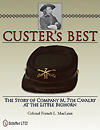
Custer’s Best: The Story of Company M, 7th Cavalry at the Little Bighorn, by Colonel French L. MacLean, Schiffer Publishing, Atglen, Pa., 2011, $69.99
George Custer had 12 companies of the 7th Cavalry with him at the Little Bighorn in June 1876, and this is the story of one of them—Company M. That “M” could stand for “Mighty” or “Most Capable.” It has been called the strongest component of the regiment, thanks in no small part to its courageous captain, Thomas French. Not one of Custer’s favorite officers, French followed Major Marcus Reno into the valley, and his company distinguished itself under fire there and later on Reno Hill. “While many aspects of the fight concerning the other 11 companies have remained veiled from historical sight,” author French MacLean writes in his well-researched, well-illustrated 239-page book, “because so many Company M troopers survived, and because so many were not shy in later expressing their views of what happened in the encounter, we can piece together a fairly comprehensive history of the company.”
The author served 34 years in the Army, and he expertly details Company M’s history, organization and leadership, as well as what troopers did during the two-day battle. He also provides many examples of bravery by members of the unit, even though none of the 24 7th Cavalry soldiers awarded the Medal of Honor for their actions at the Little Bighorn were from Company M. Exactly why is uncertain, but it probably had something to do with Captain Frederick Benteen’s failure to endorse 1st Sgt. John Ryan for the MoH, which apparently prompted French to withdraw his whole list. MacLean suggests that 10 members of Company M merited serious consideration for the decoration, including French himself, Ryan, Sergeant Henry Charles Weihe (aka Charles White) and seven privates. Weihe’s recollections are among the most interesting and controversial (he had plenty to say about Reno’s intoxication and cowardice and the failure of the major and most other officers, but not French, in the valley fight). Little Bighorn researcher Walter Mason Camp gained access to the Weihe “diary” in 1909 but didn’t have the chance to interview the sergeant, who had died three years earlier. Amazingly, the 1879 Reno Court of Inquiry called no witnesses from Company M, which, MacLean writes, “contributed to an incomplete accounting of events in that official proceeding.” That said, the author does recognize that members of Company M had their faults, too, noting, “The 58 Company M men who participated in the fight racked up a total of at least 62 courts-martial.”
—Editor




